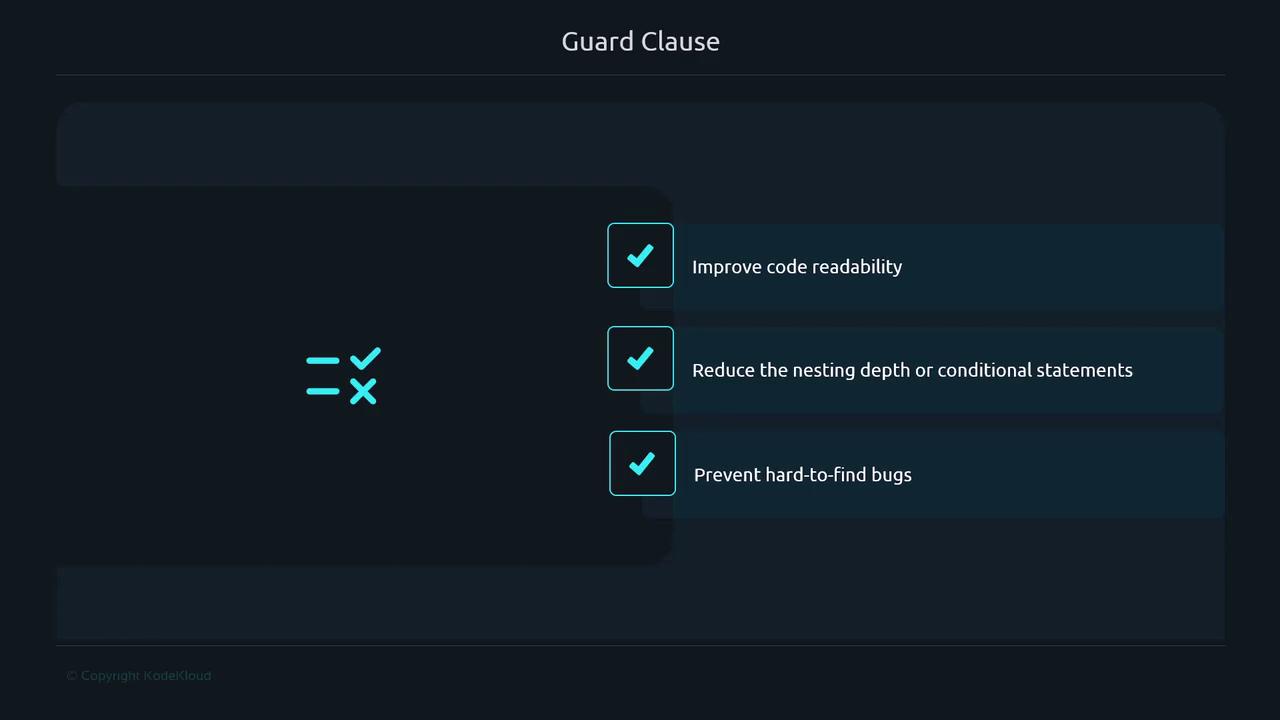Advanced Bash Scripting
Refresher
Guard clause
Guard clauses are a proven pattern in Shell scripting to handle error cases upfront—exiting when preconditions aren’t met—so that the main logic remains flat, readable, and maintainable. By bailing out early on failures, you avoid deeply nested conditionals and reduce the risk of bugs.
Note
Guard clauses help you validate inputs, permissions, or environment states at the top of your script. This keeps the primary workflow free from repetitive checks.
1. Simple if-else Example
A straightforward file existence check using an if-else block:
#!/bin/bash
# Check if a file exists
if [[ -e myfile.txt ]]; then
echo "File exists"
else
echo "File does not exist"
fi
2. The Pitfall of Nested Conditionals
When you chain several checks, your script can become difficult to read and maintain:
#!/bin/bash
# Bad example: many nested checks
if [[ "${USER_NAME}" == "admin" ]]; then
if [[ -e "${FILE_PATH}" ]]; then
if [[ -s "${FILE_PATH}" ]]; then
run_process
else
echo "File exists but is empty"
fi
else
echo "File does not exist"
fi
else
echo "User is not admin"
fi
exit 0
3. Refactoring with Guard Clauses
First, declare constants and helper functions:
#!/bin/bash
readonly FILE_PATH="/home/ubuntu/guard_clause/file.txt"
readonly USER_NAME="admin"
run_process() {
echo "running process..."
}
Next, validate each precondition at the top. Exit immediately on failure:
#!/bin/bash
readonly FILE_PATH="/home/ubuntu/guard_clause/file.txt"
readonly USER_NAME="admin"
run_process() {
echo "running process..."
}
# Guard clauses
if [[ "${USER_NAME}" != "admin" ]]; then
echo "User is not admin"
exit 1
fi
if [[ ! -e "${FILE_PATH}" ]]; then
echo "File does not exist"
exit 1
fi
if [[ ! -s "${FILE_PATH}" ]]; then
echo "File exists but is empty"
exit 1
fi
# Main logic
run_process
exit 0
Notice how each check uses a negative test (!=, ! -e, ! -s) to bail out early. Only when all conditions pass does the script reach run_process.

4. Guard Clause for Command-Line Arguments
You can apply the same pattern to verify script arguments. Here’s a basic example that ensures an argument is provided before cloning a Git repository:
#!/bin/bash
# Bail out if no argument is supplied
if [[ -z ${1} ]]; then
echo "Usage: $0 <git-repo-url>"
exit 1
fi
git_url="${1}"
clone_git() {
git clone "${git_url}"
}
clone_git
exit 0
Warning
Always validate user input to prevent unwanted behavior or security issues. Exiting early helps you avoid partial or corrupted operations.
5. One-Line Guard Clauses with Logical Operators
Bash’s && and || allow you to write compact guard clauses:
OR (
||): Execute the right side if the left side fails[[ -f "file.txt" ]] || echo "file does not exist"AND (
&&): Execute the right side if the left side succeeds[[ -z ${1} ]] && echo "argument empty"
To include an exit in a one-liner, group commands with { …; }:
[[ -f "file.txt" ]] || { echo "file does not exist"; exit 1; }
Common Guard Clause Patterns
| Operator | Behavior | Example |
|---|---|---|
| ` | ` | |
&& | Run right side only if left side succeeds | [[ ${USER} == root ]] && echo "Running as root" |
! | Negates the test, useful for early exits | [[ ! -r file ]] && { echo "Cannot read file"; exit 1; } |
Links and References
Watch Video
Watch video content